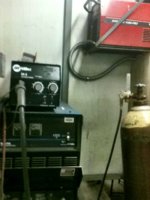hey folks, I've been mostly letting project bike chopper sit all summer, since it's too hot and steamy out there in the carport to mess with it.
but I went ahead and signed up for welding again - the same one I took like 10 years ago, but dropped out of. So this one started the same, just running bead after bead after bead of stick. 6010 or 6011 electrodes. Very easy to start up, and it'll weld through most grunge. So I did that for a couple weeks.
But last night he put me on a big MIG welder that runs flux core wire PLUS gas. And that thing is sweet. Just makes nice, non-porous, nice shaped, clean welds.
When I tear my bike down, since I'm nearly done with the mock-up, wow I'd sure love to have that welder to work with.
But anyway, next class I will bring some metal from home, of the types I will be joining, like bungs to tubing, or tabs to tubing. Hopefully the instructor will be OK with that.
Once I DO have to go back to using my little Lincoln Weld Pak, is I'm gonna go ahead and try flux core wire (you have to change the polarity for that) and see if it's any more of a sure thing than with the gas. I've just never been able to get the gas metered out just right. Plus I want to find out if I can try using flux core wire PLUS gas, like the big welder at school. Or if there's a reason NOT to try that with my little welder.
Anyway, I just can't express the difference between the welds from the big MIG welder and a. the stick welder and c. my little wire feed welder at home.
but I went ahead and signed up for welding again - the same one I took like 10 years ago, but dropped out of. So this one started the same, just running bead after bead after bead of stick. 6010 or 6011 electrodes. Very easy to start up, and it'll weld through most grunge. So I did that for a couple weeks.
But last night he put me on a big MIG welder that runs flux core wire PLUS gas. And that thing is sweet. Just makes nice, non-porous, nice shaped, clean welds.
When I tear my bike down, since I'm nearly done with the mock-up, wow I'd sure love to have that welder to work with.
But anyway, next class I will bring some metal from home, of the types I will be joining, like bungs to tubing, or tabs to tubing. Hopefully the instructor will be OK with that.
Once I DO have to go back to using my little Lincoln Weld Pak, is I'm gonna go ahead and try flux core wire (you have to change the polarity for that) and see if it's any more of a sure thing than with the gas. I've just never been able to get the gas metered out just right. Plus I want to find out if I can try using flux core wire PLUS gas, like the big welder at school. Or if there's a reason NOT to try that with my little welder.
Anyway, I just can't express the difference between the welds from the big MIG welder and a. the stick welder and c. my little wire feed welder at home.

